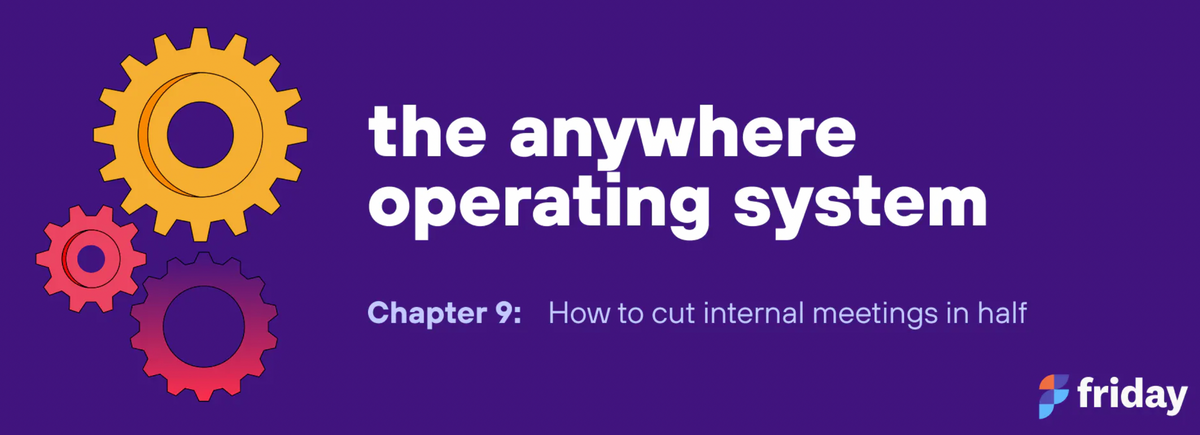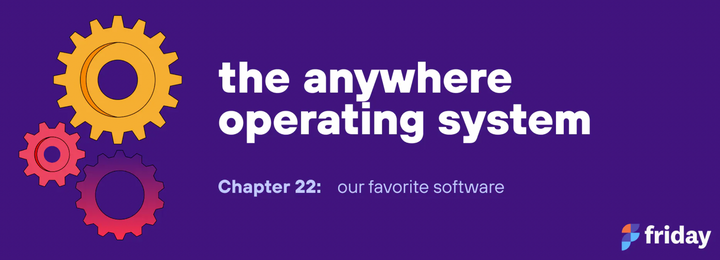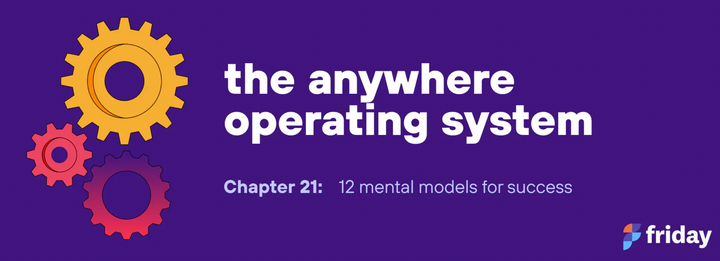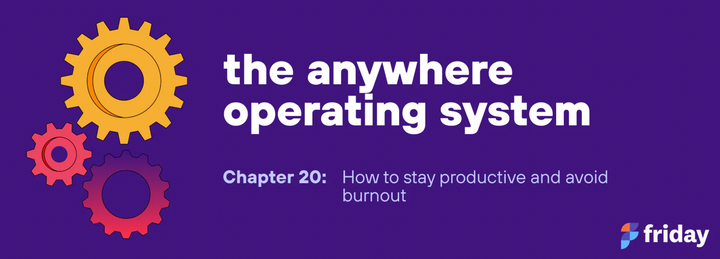Chapter 9: how to cut internal meetings in half

If you consider a flexible workplace where your team can do its best work at a time that makes the most sense for the individual, one of the biggest roadblocks in our way is unnecessary meetings.
External meetings tend to be higher value conversations as you are working with a prospect, customer, or client. These conversations are difficult to ignore and can be a great way to build better relationships.
On the contrary, people regularly complain about how much time they spend in internal meetings with co-workers. The COVID-19 pandemic highlighted this problem. According to Microsoft, the average person spent 10% more time in meetings when shifting to remote at the beginning of the pandemic. Additionally, people spent 18% more time in 1:1 meetings and 10% more time in social team meetings and happy hours.
What if there was an easy way to dramatically reduce the time we spend in internal meetings? What if we could walk into a Monday morning staff meeting and instantly jump into the important conversations, instead of going around in a circle and sharing status updates?
Imagine all the time you’d save!
In the remainder of this chapter, I’m going to show you how to create a predictable process to spend half as much time in internal meetings.
Share asynchronous updates before you meet
The key foundational principle to spending less time in meetings is simple: share written updates before you meet. Meetings are for collaboration, relationship building, and removing blockers, not sharing high-level facts and information.
“I’ve tried that before, it doesn’t work”
I don’t want to be the bad guy, but you probably aren’t doing it right. At a former employer, we decided to share written updates on a Friday afternoon before our Monday morning staff meeting. It was a great idea! At least in theory.
In reality, it was a disaster.
Each person tasked with sharing a status update had to manually set a calendar reminder to remember to fill out a Microsoft Word document. Some people would adhere, but most of the team would forget. Then, we’d show up to the meeting on Monday and the leader would realize that most of the team didn’t write an update. No one had read the updates either.
So, what did we do? The team lead resorted to doing what any rational person would do…they went around in a circle asking everyone to share what they were working on.
At this point, the small group of people who prepared and followed directions would become demoralized. They wasted their time compiling a written update! This negative feedback loop compounds and, over time, everyone stops sharing written updates, leaving you demoralized.
Too many points of failure!
The reason why sharing updates before you meet rarely works is because the process requires too much manual effort. There are many ways this seemingly simple process can break down.
For example:
- Participants need to set a reminder to share the update, which may or may not happen.
- A busy team leader doesn’t have time to chase after people and remind them to share an update. This is a waste of time.
- The update is most relevant and important for the leader, while individual contributors may feel like they don’t need to know everything that’s going on with everyone on the team.
- It takes time to remember and share what you accomplished. People will spend time digging through their email, calendar, and task apps to remember what they accomplished over the past week.
- The leader may need to manually collate the updates into a digestible and shareable report, especially if their boss (or another external stakeholder) wants to know what the team is working on. This is time consuming and not fun.
- If you want your team to show up prepared, you will need to share out the report before the meeting and hope everyone reads it.
Can you see why this great idea rarely works in real life? There’s too many ways this good idea could go wrong.
A better option
I’d encourage you not to ditch the idea of sharing updates before you meet; but, instead, offload as much of the boring stuff to a computer to help you automate and reduce the potential points of failure.
For example:
- What if there was an easy way to ping your entire team to share an update? Ideally, this ping could be sent in a tool like Slack or Microsoft Teams so it would rise above the noise of a busy email inbox.
- When people share updates, what if the work was automatically pulled into view without needing to visit other apps and project management tools?
- What if the updates were highly structured and filled with context, so you could tease out information vs. collecting vague agenda items and placeholders for future discussion?
- What if you could automatically ping people who have not responded without annoying the people who already shared an update?
- What if there was a way to make sharing updates more fun and rewarding for your team vs. being perceived as a chore?
- What if the updates were automatically compiled into a shareable report AND pushed out to your team before the meeting happens?
If you reduce the barriers to sharing information on a regular basis, you can create a more predictable flow to your communication.
To use an analogy, think of plumbing in a home. The pipes feed water throughout the home, but you also need pumps to instill logic for when water should move from one location to another.
If you don’t have pumps, you will get a flood of water in one location and a trickle in another. This is what happens at work – you may be overwhelmed by the constant pings from your immediate team in chat (a flood of information), but you may feel like you have no idea what’s going on in another part of the company (a trickle).
Likewise, you need to create systems and repeatability in the way that you communicate. Email, workplace chat, and Zoom are like pipes that enable the flow of communication, but you need pumps to create predictability.
Routines for Success
While there is no perfect solution, we use the software we build at Friday to automate asynchronous updates. We only have three regularly scheduled meetings a month with this playbook:
1. Weekly Kickoff
On Monday at 11 a.m. (in each person’s respective timezone), we ask the entire company the following questions asynchronously:
- How was your weekend?
- What do you aim to accomplish this week?
The answers to these questions are a mixture of work and fun, exactly what you might discuss in a weekly staff meeting. People will regularly share photos of a hike or family event; but, as a leader, I also can see what people aim to accomplish. This creates accountability, but also helps me privately course-correct and nudge if there’s something more important that someone needs to tackle.
2. Daily Standup
Throughout the week, we also have a daily standup where we ask the following questions at 9 a.m.:
- What did you accomplish yesterday?
- What are you working on today?
- Anything else you’d like to share?
In all honesty, this is probably the least useful routine we run because it’s so tactical and in the weeds, but it’s also a great way for people to share their work. The last question gives everyone the opportunity to share if they will be out for an appointment or break.
You can use this routine to supplement or replace your daily standups and huddles.
3. Friday Check-In
Unlike other routines that are transparent and visible to the group, I run another routine that is only visible to me, called the Friday Check-In. At the end of the week, the people who report to me can quickly answer the following questions:
- How did you feel about the week? (emoji question)
- How productive do you think you were this week? (1-10 scale)
- What went well this week?
- What was the worst part of your week? Anything I can do to help?
These questions may sound similar to questions you might ask in a 1-1 meeting, which is what this routine aims to complement or replace.
What’s cool about this routine is that if you give people some time to collect their thoughts, they will give you amazing feedback and insight that you would not normally get in a face-to-face interaction.
You can then use the information that your team shares asynchronously to kickstart better conversations instead of awkwardly spending the first fifteen minutes trying to figure out what’s going on.
If you use this routine, you can hold on-demand 1:1 meetings and have targeted discussions instead of holding meetings where you show up, only to realize that everything is great and you didn’t need to have the meeting at all.

4. Monthly Review
At the end of the month, we’ll review the past month and look forward to what we need to accomplish next. We ask the following questions asynchronously:
- How effective do you think we were this month? (1-10 scale)
- What is the reason for your score? (1-10 scale)
- What do you think WE should work on next month?
- What do you think YOU should work on next month?
The responses to this monthly routine help me cut down prep time for monthly kickoff meetings. It also helps me understand what each person would like to focus on in the month ahead.
“Asking people to share async updates is impersonal!”
There is no perfect solution and I’m not going to pretend that this approach is perfect for every company.
With that being said, I would argue that the benefits of async updates are much greater than the downside. Your employees are tired of spending their day on video calls and bad meetings (Zoom fatigue anyone?). If you can create an environment where your team has more time to do meaningful work or have the flexibility to take a break because they don’t have a useless status update meeting, that’s a great outcome for all!
This matters when you work with people across time zones. There is never a good time to hold a meeting for everyone. Someone may take a call early in the day, while another person may need to jump on a call late in the evening.
A few more tips:
If you decide to automate asynchronous updates, make sure to:
- Acknowledge the response — if someone shares a great update, make sure you thank them for it. If you use a tool like Friday, you can leave an emoji or comment so they know the message has been received.
- Remember that meetings are a tool in your toolbox — the goal here isn’t to eliminate all your meetings. It’s to have fewer, better meetings.
Aisha’s perspective
“Friday was the first company at which I worked where I could respond to automated routines. Before, at my office jobs, I had my boss constantly check up on me to make sure I was staying on track. It certainly helped me stay focused, but I kind of got too comfortable.
When the pandemic hit, it became harder and harder to get the work done, not only because of COVID-19, but also because I no longer had that constant presence behind me.
During my time at Friday, I respond to different routines. The Daily Standup is one I use a lot, and it helps keep me on track. I write out everything I have to do, and I even write what I accomplished the day before. It’s a good reminder of what I have to do, and also the progress I made along the way. Not only is my progress viewable to me, but I can also view my coworkers’ Daily Standup as well. It’s cool to see what everyone else is doing. I focus more on the marketing side of Friday, so it’s nice to see the design side, or the product side that my coworkers handle.
One thing I greatly enjoy about Friday’s routines is the ability to answer icebreakers at the end of completing a routine. Just like how you would talk to and get to know a coworker during your in-person lunch break, icebreakers let me know more about my coworkers that are unrelated to work. It definitely helps me feel like I’m connected to the team, and I’m more willing to share things in the hopes that someone else will relate!”
In Conclusion
If you disconnect information sharing from meetings, you will spend less time in meetings. This isn’t rocket science. Meetings are best for building relationships, removing blockers, and brainstorming. Stick to that. Your team will thank you.
Want to keep reading? In the next chapter we'll talk about how to build company culture.


